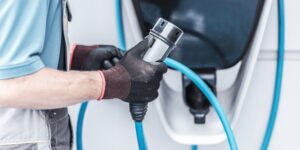Are you wondering whether a car battery operates on DC or AC power? The answer is straightforward: car batteries produce direct current (DC) electricity. But let’s delve a little deeper to understand why this is the case. DC power flows in a single direction, making it ideal for powering the electrical components of a vehicle. Understanding the essential workings of a car battery and its role in providing the necessary electrical power is crucial for every car owner. So, let’s explore the world of car batteries and how they power our vehicles.
Is a Car Battery DC or AC?
Car batteries are a vital component of any vehicle, supplying the electrical energy necessary to power various systems and start the engine. However, many people may wonder whether car batteries are DC (direct current) or AC (alternating current). In this article, we will explore the nature of car batteries and provide a clear answer to this common question.
Understanding Direct Current (DC)
To start our exploration, let’s delve into the concept of direct current (DC). DC refers to the flow of electric charge in a single direction, maintaining a constant polarity. Batteries, such as those used in most vehicles, are a primary example of DC power sources.
When a car battery is connected to the vehicle’s electrical system, it supplies a steady stream of direct current. This allows various components, such as lights, radio, and ignition systems, to function properly. Additionally, DC power is necessary to start the engine by activating the starter motor.
The Inner Workings of a Car Battery
To better understand why car batteries produce DC power, let’s examine their internal structure and functioning:
- Cell Structure: A typical car battery is composed of six individual cells, each generating around 2.1 volts of potential difference. These cells are connected in series, providing a combined voltage output of approximately 12.6 volts.
- Chemical Reaction: Car batteries utilize a chemical reaction known as an electrochemical process. Inside each cell, lead plates are submerged in an electrolyte solution composed of sulfuric acid and distilled water. This chemical reaction generates DC electricity.
- Lead-Acid Battery: Car batteries fall under the category of lead-acid batteries. Lead serves as the anode (+) while lead dioxide acts as the cathode (-). The sulfuric acid in the electrolyte solution acts as the medium through which ions flow, completing the circuit.
When the battery is discharged, the chemical reaction converts lead and lead dioxide into lead sulfate. However, during the charging process, the reaction is reversed, converting the lead sulfate back into lead and lead dioxide.
Alternating Current (AC) in Vehicles
While car batteries provide DC power, there are instances in a vehicle’s electrical system where AC electricity is required. This is accomplished through the use of an alternator.
An alternator is responsible for converting mechanical energy from the engine into electrical energy. The alternator’s rotor spins within a stator, generating an alternating magnetic field. This magnetic field induces an alternating current in the stator windings, producing the required AC electricity.
The AC produced by the alternator is subsequently converted into DC using a rectifier. The rectifier contains diodes that allow the flow of current in a single direction, effectively transforming the AC into DC power. This rectified DC is then used to charge the car battery, power the vehicle’s electrical systems, and maintain the battery’s charge.
Importance of DC Power in Vehicles
DC power is crucial for various aspects of a vehicle’s operation. Here are some key reasons why car batteries and DC power are vital:
- Starting the Engine: When you turn the ignition key, the battery supplies a surge of DC power to the starter motor. This motor then cranks the engine, initiating the combustion process and enabling the vehicle to start.
- Powering Electronics: From headlights and taillights to the audio system and dashboard display, numerous electronic components in a car depend on a stable supply of DC power. The battery ensures that these systems can function seamlessly.
- Backup Power: In case of alternator failure or when the engine is turned off, the battery provides uninterrupted power to essential systems. This prevents the loss of critical functions, such as emergency lights or safety equipment.
The Role of Inverters
While vehicles primarily rely on DC power, there may be situations where AC electricity is needed. For instance, some electronic devices, such as laptops or portable game consoles, require AC power to operate.
To accommodate these scenarios, inverters are used. An inverter is an electronic device that converts DC power from the car battery into AC power. It allows you to plug in and use devices that require AC electricity while on the go.
Inverters vary in size and capacity, with some designed to power small devices and others capable of providing enough electricity to run larger appliances. It is important to select an inverter that matches your power requirements and the capacity of your car battery.
In conclusion, car batteries are DC power sources, supplying a steady stream of direct current to power various electrical components and start the engine. While the vehicle’s alternator produces AC electricity, it is subsequently rectified into DC power before being used to charge the battery and energize the car’s systems.
Understanding the nature of car batteries and the type of electricity they produce is essential for maintaining and troubleshooting electrical issues in your vehicle. With this knowledge, you can make informed decisions when it comes to choosing electronic devices, inverters, and ensuring a reliable power supply for your car’s electrical systems.
Frequently Asked Questions
Is a car battery DC or AC?
A car battery is a direct current (DC) power source.
What is the difference between AC and DC?
AC stands for alternating current, which periodically changes direction, while DC stands for direct current, which flows in one direction.
Why is a car battery DC?
A car battery is DC because it needs to provide a consistent and steady flow of electrical power to the various components of a vehicle, such as the starter motor and ignition system.
Can a car battery produce AC power?
No, a car battery cannot produce AC power on its own. However, with the help of an inverter, which converts DC power to AC power, you can use the car battery to power AC devices.
What devices in a car use DC power from the battery?
A car battery primarily powers the DC devices in a vehicle, including the starter motor, lights, radio, power windows, and other electronics.
What is the voltage of a car battery?
The voltage of a typical car battery is 12 volts. However, it is important to note that the actual voltage may vary depending on the state of charge and the specific vehicle.
Final Thoughts
In conclusion, the car battery is a direct current (DC) power source. It provides the necessary electrical energy to start the engine and power the various electrical systems in the vehicle. The car battery stores a chemical energy that is converted into electrical energy, supplying a stable DC output. This DC power is essential for the operation of the car’s electronics, such as the lights, radio, and dashboard displays. Understanding that a car battery is DC, rather than alternating current (AC), is crucial for correctly handling and maintaining the battery for optimal performance and longevity.


